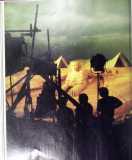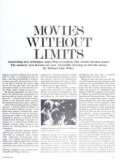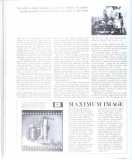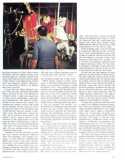



Astonishing new techniques make films so realistic that viewers become actors. The cameras' eyes become our eyes, irresistibly drawing us into the action.
Suppose yourself a brilliant film director avid to create a technological tour de force — the most breathtaking 3-D documentary yet made, an experience so lush, so real that it snatches the viewer right out of his seat and wafts him into the actual movie itself, as if he were the camera. What subject would you choose?
The human imagination, of course. Even better: the kaleidoscopic imagination of a ten-year-old boy lying in bed with "nothing to do." A perfect way for the camera/viewer to soar about the earth, scorning the limitations of gravity, space, and time.
Such is the beguiling premise of Magic Journeys, a fifteen-minute distillation of director-producer Murray Lerner's own pioneering journeys through the magic realms of advanced film technology. Opening this month in the Journey Into Imagination pavilion at EPCOT Center (Experimental Prototype Community of Tomorrow), at Walt Disney World, near Orlando, Florida, Magic Journeys dramatizes the interdependence of art and technology.
In just a few decades, progress in film-making has derived partially from a succession of technical coups — sound, color, Vistavision, Cinemascope, Cinerama, 3-D, computer-generated imagery, Dolby stereo, digital sound. Some of these innovations (early 3-D, for example) were spawned by crass concerns (fear of losing audiences to television and now to cable TV). But meanwhile the industry's artists have merrily seized every technological opportunity to engage the viewer so physically that soon the feeling of being inside a movie may be quite normal.
So it seems in Magic Journeys, a three-dimensional rendering of a child's day-dreams in constant metamorphosis. The boy (played by Liddon Cowden) is whisked everywhere by the sheer force of his boundless musings. In a rush of changes, a poppy field fades into pink clouds full of floating camels and castles. Birds in the sky become fish in the sea. A horse galloping on a beach is suddenly frozen as a carousel stallion. A Siamese cat becomes a sphinx that becomes a circus lion. The film is a stream of dazzling images dissolving in and out of one another, each prefiguring the next, like a magician shaking birds out of his sleeve.
Murray Lerner, fifty-five years old, derived this notion from long experience with cinema-verite documentaries (his movie From Mao to Mozart won an Oscar for being the best feature documentary of 1980). He began it in a Manhattan film studio in 1980; the eventual cost was nearly $7 million, furnished by Walt Disney Productions and Eastman Kodak. The steep price — for a quarter-hour movie — is more understandable when you realize that Magic Journeys consists of 110 sequences, each of them meticulously charted on a storyboard beforehand so that appropriate technology could be devised before a single foot of film was shot. Lerner was not just making a clever documentary; he hoped to reinvent 3-D movies, imbuing his own version with unprecedented dignity and quality
[…]